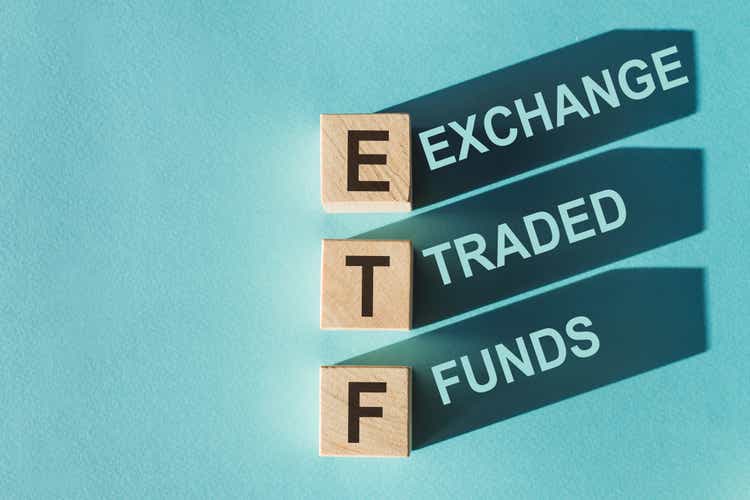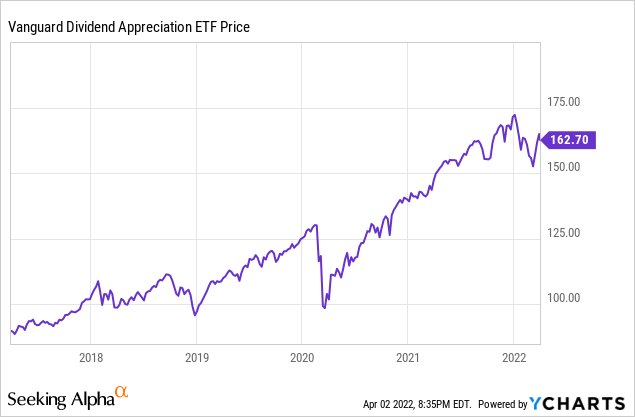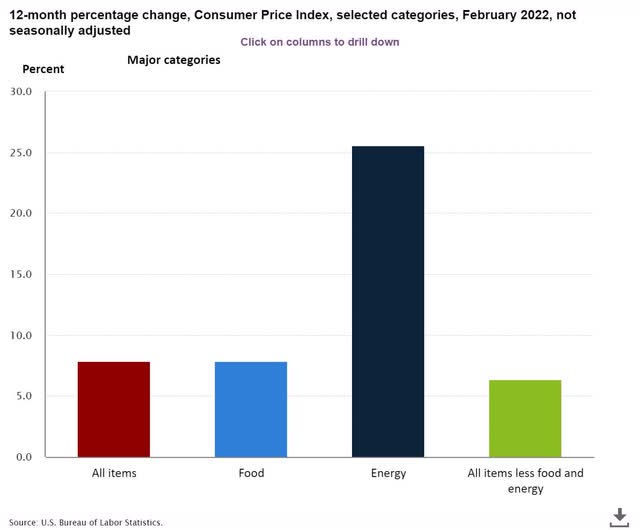Nastassia Samal/iStock via Getty Images
Investing in 2022 isn’t getting any easier. With inflation consistently running above 5% according to the consumer price index, many indexes such as the S&P 500 (SPY) at or near record highs, and yields on funds and stocks the lowest these payouts have been in some time, investors are having to work harder than in previous years.
One of the most popular ways to invest is through exchange traded funds, or ETFs. Some of the most popular exchange traded funds are dividend and income-based funds, one such fund is the Vanguard Dividend Appreciation Fund (NYSEARCA:VIG).
This fund has nearly $64 billion under management and seeks to match the performance of the Nasdaq US Dividend Achievers Select Index. The fund focuses on large-cap companies. The fund is well-diversified with 270 holdings, the largest 5 holdings are Microsoft (MSFT), JPMorgan (JPM), Johnson & Johnson (JNJ), UnitedHealth Group (UNH), and Procter & Gamble (PG). The fund’s holdings are 17% financials, 16% industrials, 15% technology, 15% consumer defensive, 15% health care, 10% consumer cyclical, 5% basic materials, 3% utilities, and 2% communications.
The fund has performed reasonably well over the last 5 years compared to other dividend funds and the S&P 500, offering investors solid income and total returns.

The average dividend growth rate of the fund over the last 10 years has been 9.26%, average dividend growth over the last 5 years has been 9%. The current yield is just 1.75%, and the dividend is paid out quarterly. The fund’s expense ratio is good at .06%
This fund has performed reasonably well compared to other funds and benchmarks, even though other dividend-based exchange traded funds such as the Schwab U.S. Dividend Equity ETF (SCHD) have performed better, and this fund has also underperformed the S&P 500 as well. The Schwab dividend fund has outperformed the Vanguard fund by 10% over the last 3 years. When you consider both income and total returns, the Schwab fund is up 65% while the Vanguard fund is up 55%. This Vanguard fund has also underperformed other funds this year that are more overweight inflation, such as the WisdomTree U.S. High Dividend Fund (DHS), and the Virtus Real Asset Income ETF (VRAI). The WisdomTree fund currently yields 2.78%, and the Virtus Real Asset Income fund, a real estate fund, currently yields 3.39%.
Investing is about the future, not the past, and this Vanguard fund is likely to underperform other exchange traded funds that offer more protection such as the Vanguard High Dividend Yield ETF (VYM), a fund that is more heavily overweight the financial and energy sectors. The Vanguard High Dividend Yield fund has 22% of its holdings in the financial sector and 13% in energy and basic materials.
Inflation has consistently been at 5% or higher for over a year now as measured by the consumer price index. With wages rising, supply chain issues continuing, and geopolitical tensions high, high prices in many sectors are likely here to stay.
Inflation has been running over 5% for over a year, and there is no reason to think inflation rates will drop significantly anytime soon. Inflation has been at over 6% for much of this year, and this fund has underperformed most leading dividend funds this year, returning negative 4.9%.
The Vanguard Dividend Appreciation Fund is overweight the financial sector, an industry obviously likely to outperform in an inflationary environment as rates rise, but this fund has no exposure to energy stocks, and very minimal exposure to commodities as a whole, since only 5% of the fund’s holdings are in basic materials. This fund does have favorable exposure to a weak dollar because the fund is exclusively large-cap holdings, so there is a lot of international leverage, but this is still an investment that is likely to significantly underperform other dividend funds more overweight energy and basic material stocks. This fund is not likely to perform well in an inflationary environment such as the one we are in, and the Vanguard fund has also been volatile for an investment vehicle heavily overweight defensive sectors such as health care and consumer defensives, with a beta of .88.
With rates still low and likely to remain low for some time, many investors are being forced to be more creative to get the same returns these individuals have gotten in previous years as indexes and funds hit record highs. Even though this Vanguard fund has performed well over the last 5 years, investors seeking stable income and solid returns in an inflationary environment are more likely to be better positioned to get inflation-adjusted returns by picking investment funds that are more heavily overweight commodities and basic materials than this investment vehicle. Funds such as the WisdomTree U.S. High Dividend Fund offer better current yields and are better positioned to offer inflation-adjusted returns in the current economic and investing environment.



Be the first to comment